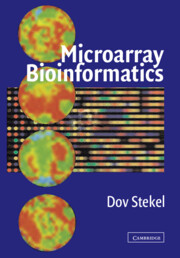Book contents
- Frontmatter
- Contents
- Foreword
- Preface
- Acknowledgments
- MICROARRAY BIOINFORMATICS
- 1 Microarrays: Making Them and Using Them
- 2 Sequence Databases for Microarrays
- 3 Computer Design of Oligonucleotide Probes
- 4 Image Processing
- 5 Normalisation
- 6 Measuring and Quantifying Microarray Variability
- 7 Analysis of Differentially Expressed Genes
- 8 Analysis of Relationships Between Genes, Tissues or Treatments
- 9 Classification of Tissues and Samples
- 10 Experimental Design
- 11 Data Standards, Storage and Sharing
- Appendix: MIAME Glossary
- Index
- Plate section
8 - Analysis of Relationships Between Genes, Tissues or Treatments
Published online by Cambridge University Press: 15 January 2010
- Frontmatter
- Contents
- Foreword
- Preface
- Acknowledgments
- MICROARRAY BIOINFORMATICS
- 1 Microarrays: Making Them and Using Them
- 2 Sequence Databases for Microarrays
- 3 Computer Design of Oligonucleotide Probes
- 4 Image Processing
- 5 Normalisation
- 6 Measuring and Quantifying Microarray Variability
- 7 Analysis of Differentially Expressed Genes
- 8 Analysis of Relationships Between Genes, Tissues or Treatments
- 9 Classification of Tissues and Samples
- 10 Experimental Design
- 11 Data Standards, Storage and Sharing
- Appendix: MIAME Glossary
- Index
- Plate section
Summary
INTRODUCTION
Microarrays are a genomic technology. Genomics is different from genetics in that it looks not at genes in isolation, but at how many genes work together to produce phenotypic effects. In Chapter 7 we saw how microarrays can be used to study genes in isolation. But much of the real power of microarrays is their ability to be used to study the relationships between genes and to identify genes or samples that behave in a similar or coordinated manner. This chapter looks at a number of analysis techniques to find and verify such relationships.
We will use two example data sets to examine the ideas of this chapter.
EXAMPLE 8.1 YEAST SPORULATION DATA (DATA SET 8A)
Budding yeast can reproduce sexually by producing haploid cells through a process called sporulation. Yeast was placed in a sporulating medium, and samples were taken at six time points following the start of sporulation and hybridised to microarrays. We want to identify groups of genes that behave in a coordinated manner in this time series.
EXAMPLE 8.2 DIFFUSE B-CELL LYMPHOMA SUBTYPES (DATA SET 8B)
Samples were taken from 39 patients suffering from diffuse large B-cell lymphomas and hybridized to microarrays. We want to identify genes that are co-regulated in this disease. We are also interested in whether there are groups of patients with similar gene expression profiles.
This chapter discusses methods that can be used to answer such questions; it is organised into the following five sections:
Section 8.2: Similarity of Gene or Sample Profiles, looks at different methods for quantifying the similarity or dissimilarity of gene expression profiles. We show how the different methods can give different results and, hence, the need to think carefully about choosing the method you use.
[…]
- Type
- Chapter
- Information
- Microarray Bioinformatics , pp. 139 - 182Publisher: Cambridge University PressPrint publication year: 2003
- 1
- Cited by



